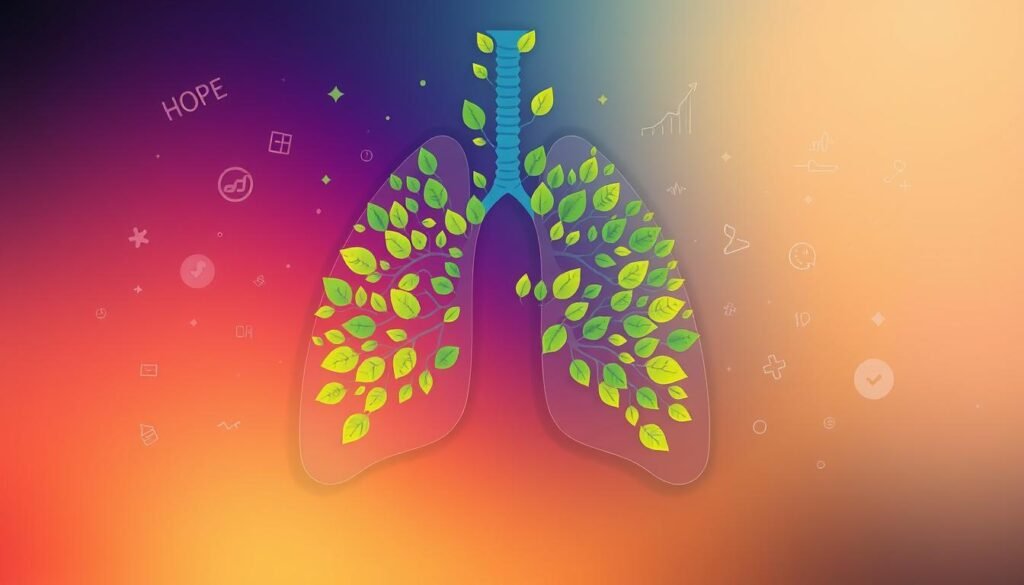Did you know less than 20% of people with lung cancer live past five years? This fact is a part of a larger issue. Lung cancer has one of the highest death rates among all cancers, only behind pancreatic cancer. Understanding these survival rates is key for patients and their families. It gives them essential info on cancer survival and lung cancer prognosis. Also, research and treatment are always getting better. This gives many people hope.
One big problem is with finding the cancer early. About 40% of lung cancers are only found when they are very advanced, at stage IV. This makes it harder for people to beat the disease. As we move forward, we’ll look at different things that affect survival rates. We’ll discuss the type of lung cancer and how early it’s found. This can help people understand what to expect in their treatment. To see more survival stats, check out these rates.
Key Takeaways
- Survival rates for lung cancer are less than 20% after five years.
- Lung cancer’s mortality rate is high, second only to pancreatic cancer.
- Many lung cancers are diagnosed at stage IV, which impacts the prognosis greatly.
- The stats differ for non-small cell and small cell lung cancers. This affects treatment plans and expectations.
- Research is making progress that may help patients live longer.
What Are Lung Cancer Survival Rates?
Lung cancer survival rates show how many people live for five years after diagnosis. These rates help us understand the success of treatments and how outcomes vary. They look at different types and stages of cancer.
The survival rates for lung cancer change a lot depending on the stage when found. Early-detected localized non-small cell lung cancer (NSCLC) has a survival rate of about 61%. But, late-detected NSCLC’s survival rate drops to 6%. This shows why finding cancer early is crucial for a better chance to live longer.
Small cell lung cancer (SCLC) has a five-year survival rate of 29% for early-stage patients. For those with more spread disease, it plummets to 3%. The overall survival rate for all lung cancer stages is about 21%. This highlights the hurdles for those diagnosed late.
Knowing these survival rates helps guide treatment choices. Early-stage NSCLC patients can have survival rates over 70% with surgery and chemotherapy. Breakthrough treatments like immunotherapy lift survival rates to 32% for advanced NSCLC.
It’s crucial for patients and doctors to know these statistics. With better screening and early detection, especially among different groups, there’s hope. We might see better survival rates and outcomes for patients soon.
Factors Influencing Lung Cancer Prognosis
The prognosis for individuals with lung cancer depends on several key factors. Knowing these survival factors helps patients and families in hard times.
The stage of lung cancer when found is very important. Early stages offer a better chance of survival than later stages. Small cell lung cancer has a better outlook in its limited stage than in the extensive stage.
Weight loss before treatment matters too. Losing more than 5% of body weight often means a worse outlook. The better the performance status, the better the expected outcome.
Women usually do slightly better than men with lung cancer. Being in good health also makes a big difference. People in good health might have surgery, which improves survival chances. But, having heart or lung problems might lead to poorer outcomes.
Cancer cell genetics play a role in how well treatments work. Certain mutations might respond better to targeted therapies. This understanding opens doors to better treatments.
Understanding these aspects is key to knowing about lung cancer prognosis. The stage of cancer, personal health, and genetic markers all affect the outcome.
Lung Cancer Statistics: A Closer Look
Lung cancer is a major health issue in the United States. It’s the top cause of cancer deaths. Each year, it outruns deaths from breast, prostate, and colorectal cancers combined. Around 225,000 new cases are recorded yearly, mainly due to smoking and the environment.
The projections for 2024 show about 234,580 new lung cancer cases. The numbers are almost the same for men (116,310) and women (118,270). The expected death count is 125,070 deaths, with men and women nearly equally affected. These numbers stress the importance of catching the disease early.
About 10% to 15% of lung cancers are small cell lung cancer (SCLC). The rest, or 80% to 85%, are non-small cell lung cancer (NSCLC). The average age at diagnosis is around 70 years. This shows how it mainly impacts older adults, especially those over 65.
The survival rates for lung cancer vary greatly. They depend on the cancer stage and type when found. The current cancer data shows nearly half of the cases are discovered at a late stage. This makes treating the disease harder. The chance of getting lung cancer is roughly 1 in 16 for men and 1 in 17 for women. This means everyone, smokers and non-smokers alike, is at risk.
New cases of lung cancer are slowly decreasing. This comes from more people stopping smoking and better screening. Continuing research aims to improve survival and outcomes for those diagnosed. By understanding these statistics, we see how critical targeted efforts and raising awareness are.
| Statistic | Value |
|---|---|
| New Lung Cancer Cases (2024 Estimate) | 234,580 |
| Projected Deaths (2024) | 125,070 |
| Percentage of SCLC | 10% – 15% |
| Average Age of Diagnosis | 70 years |
| Incidence Rate for Men | 1 in 16 |
| Incidence Rate for Women | 1 in 17 |
| Percentage of Cases at Distant Stage | ~50% |
Understanding the Survival Rate of Lung Cancer
The survival rate of lung cancer is key in figuring out the cancer outlook for patients. It uses a five-year survival statistic to show how many patients are still alive five years after being diagnosed. Right now, the overall five-year survival rate for lung cancer is about 26.7%. This is much higher than the 12.4% back in the mid-1970s, showing how much treatments have improved.
When we look closer, we see that non-small cell lung cancer (NSCLC) patients have better outcomes than those with small cell lung cancer (SCLC). The five-year survival rate for SCLC is just 8.6%, which is quite low. But, NSCLC has different types, like squamous cell lung cancer with a 25.2% survival rate, and large cell lung cancer at 22.8%. Amazingly, patients with a type called minimally invasive adenocarcinoma have a 98% survival rate if they get surgery early on.
Many factors like age, sex, and ethnicity impact how well lung cancer patients do. Younger people, especially with large cell lung cancer, tend to live longer. Women also have better chances than men in beating this disease. However, survival rates differ among races, with African Americans often having lower rates than White or Asian people. But, there’s hope. New treatments, such as checkpoint inhibitors, are improving survival chances for many.

Lung Cancer Survival Rate by Stage
Lung cancer is grouped into stages. This depends on tumor size and if it has spread. Knowing the stage helps understand the prognosis. It also assists in making treatment choices. Each stage shows a different level of disease progress. This affects survival rates by stage.
Overview of Lung Cancer Stages
Lung cancer stages go from I to IV. Stage I shows disease only in the lung. By Stage IV, the cancer has spread more widely. Each stage means more cancer spread. This affects survival chances. Here’s a quick look at the stages:
- Stage I: Cancer hasn’t spread outside the lung.
- Stage II: Cancer has reached nearby lymph nodes.
- Stage III: It’s moved to chest lymph nodes.
- Stage IV: Now, it’s in other body parts, like bones or liver.
Statistical Breakdown of Survival Rates by Stage
The chance of surviving lung cancer varies a lot by stage. This underscores why early finding is key. Here are survival stats by stage:
| Stage | 5-Year Overall Survival Rate | 5-Year Specific Survival Rate |
|---|---|---|
| Stage I | 76.9% | 82.3% |
| Stage II | 56.1% | 59.7% |
| Stage III | 32.6% | 37.2% |
| Stage IV | 21.4% | 26.4% |
These numbers show diagnosing lung cancer early boosts survival chances. People with early-stage cancer often have good outcomes. But, facing cancer at advanced stages means bigger hurdles.
Exploring Lung Cancer Survival Rate by Age
Age is key in figuring out the lung cancer survival rate by age. Younger people, especially those under 60, often have a better chance of living longer than older adults. For example, those 80 and up have a median survival of only 1.0 years. This shows a big difference from younger patients, who can expect more time.
A study looked at 3,481 people with lung cancer. It linked age with how well patients fared. People between 60 and 69 had an 89% chance of getting treatment. But, this chance fell to 71.8% for those 80 and older. Age clearly affects how well patients can access treatments and their survival odds.
The same research found a big gap in 1-year survival rates. Younger patients had a 67.3% chance of surviving a year, whereas older ones had only 42.5%. This shows the importance of plans that consider both the patient’s age and health.
For those with advanced lung cancer, age raises the risk of dying. Patients over 80 face a 28% higher risk of death than those under 60. This highlights how crucial it is for doctors to think about age in their plans. Doing so could lead to better results for patients of all ages.
Looking for more on lung cancer stats and survival rates? The American Cancer Society offers in-depth information and advice.
Stage 4 Lung Cancer Survival Rate: Key Insights
Stage 4 lung cancer is a tough challenge for patients and doctors. The cancer spreads to other parts, making survival rates low. These stats show that 60% to 70% of non-small cell lung cancer cases are found at stage 4, which is worrying.
Challenges and Treatments Available
Survival at this stage is slim, with about a 10% chance of living five more years. Treatments like chemotherapy and radiation help with symptoms but don’t cure the disease. Newer treatments have extended the survival time a little, but the situation remains difficult.
About 25% to 30% of patients with stage 4 NSCLC die within three months of finding out they have cancer. Targeted therapies help some patients, especially if they have certain genetic traits. For example, 51% of Asian patients have tumors that respond well to these treatments, but only 8% of patients in the West do.
Check out more info on survival rates and treatment options for a full picture of stage 4 lung cancer. Knowing all the factors that affect survival rates helps patients and families make better choices about treatment.
Looking into personalized treatment options can lead to longer survival for some. It’s important to look at each case individually, considering age, health, and genetics.
Lung Cancer Survival Rate After Treatment
The lung cancer survival rate after treatment varies a lot. It depends on the lung cancer type, how early it is found, and how well one reacts to treatment. For example, non-small cell lung cancer (NSCLC) results differ by stage. Early-stage NSCLC has a 65% five-year survival rate. For cancers that have spread a little, it’s 37%. And for those that have spread far, it’s just 9%.
People with small cell lung cancer (SCLC) have it harder. Their five-year survival is 30% if the cancer is just in one spot. It drops to 18% if the cancer has spread nearby. And it goes down to 3% if it’s found in distant parts of the body. These numbers show that treatments might help some more than others. But the outcome is often tied to how much the cancer has grown and its nature.
New treatments are being discovered that could better these numbers. Trials for new therapies are important, especially for advanced cancer. Sticking to treatment and regular check-ups are key. They help manage the illness and check for cancer coming back.
Survival rates like the five-year outlook offer a broad view. But they can’t predict what will happen for each person. Everyone’s result will vary due to their overall health, how old they are, and how they respond to treatments. For those facing lung cancer, talking about tailored treatment options and what to expect with doctors is crucial.

Lung Cancer Life Expectancy: What to Know
Lung cancer life expectancy varies a lot. It depends on the lung cancer type, when it’s found, and the treatment used. Knowing these details helps us understand average life expectancy for lung cancer patients. It also shows how treatment can change survival rates.
Average Life Expectancy for Lung Cancer Patients
The average life expectancy for lung cancer is usually less than two years. But, early-stage lung cancer patients can live longer than five years with effective treatment. Patients with non-small cell lung cancer (NSCLC) in stages 1 or 2 might live 33-55 months.
However, later stages with metastatic spread show shorter survival. Stage 4 NSCLC patients might only live 4-9 months.
Impact of Treatments on Life Expectancy
Treatment significantly helps increase lung cancer life expectancy. Surgery for NSCLC can lead to an average survival of 76.7 months. This is much better compared to untreated patients, who live about 7.15 months with NSCLC. Advanced treatments like chemotherapy, immunotherapy, and targeted therapy bring hope to many.
For instance, NSCLC patients getting both immunotherapy and chemotherapy can live about 13.37 months on average.
The Importance of Early Detection in Survival Rates
Finding lung cancer early is key to helping patients live longer. Techniques like low-dose CT scans are the best for catching lung cancer early. This is especially true for people at high risk. Studies show that spotting lung cancer early leads to much better chances of survival.
The use of low-dose CT scans has shown an 81% chance of living 20 years after a lung cancer diagnosis. Sadly, very few people who should get screened actually do. We need to make more people aware of how important early screening is.
People found to have lung cancer early, especially at stage I, have a 95% chance of living for five years. But, for those found at stage IV, only 10% live that long. These numbers show the power of early detection in changing a patient’s future.
| Stage | 5-Year Survival Rate | 20-Year Survival Rate |
|---|---|---|
| Stage I | Exceeds 90% | 81% |
| Stage IV | Less than 10% | N/A |
The International Early Lung Cancer Action Program (ELCAP) found an interesting fact. People who smoked for less than ten years have an 85% chance of living 20 years after being diagnosed. The length of time someone has been exposed to smoke affects their chances. That’s why regular screenings are critical for everyone at risk.

Understanding Relative Survival Rates in Lung Cancer
Relative survival rates are key in looking at lung cancer. They compare patients to people of the same age and sex. This helps us understand how lung cancer changes life expectancy.
A 5-year relative survival rate of 70% means lung cancer patients have a life expectancy like 70% of people without the cancer. The 5-year survival rates for lung cancer are mostly between 10% to 20% from 2010 to 2014. But, Japan has a high rate of 32.9%, and India’s is low at 3.7%.
Age and gender affect survival greatly. Younger patients and women tend to do better. For example, they often have higher 5-year survival rates worldwide. People with adenocarcinoma, a type of lung cancer, usually have a better outlook.
In China, the survival rates are noteworthy. Men in Jiangyin had a 5-year rate of 27.90%, and women had 31.62%. It’s key to understand these facts since rates vary a lot by the cancer’s stage, showing the complexity of predicting lung cancer.
The American Cancer Society provides important data on lung cancer rates. Such information is critical for caring for and treating lung cancer. It gives patients and doctors valuable insights.
Knowing the link between Chronic Obstructive Pulmonary Disease (COPD) and lung cancer is also crucial. This knowledge can lead to early diagnosis and better treatment choices. For more on this topic, read here.
Conclusion
It’s vital for patients and their families to understand lung cancer survival rates. This helps them deal with the diagnosis. Knowing key factors like the stage at diagnosis, age, ethnicity, and treatment options matters. It helps them grasp their situation and what lies ahead.
The overall 5-year survival rate for lung cancer stands at 22.6%. This statistic is crucial for people to understand where they stand.
Treatment for lung cancer is getting better thanks to research. This means a more hopeful future for many patients. Early detection is especially important. When found early, the survival rate can jump to an impressive 52.2%.
When patients know about their condition, they can work better with their doctors. Being informed leads to better choices for their health. In turn, this can lead to a better life quality and higher survival chances, giving much needed hope.